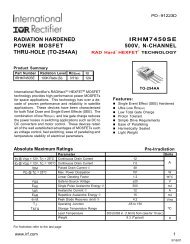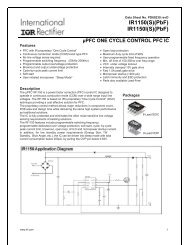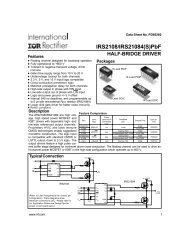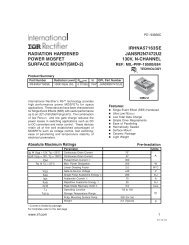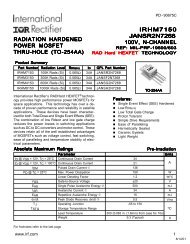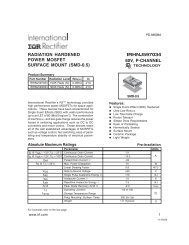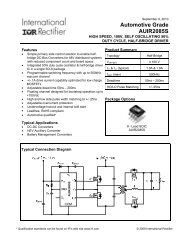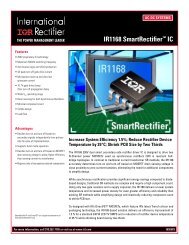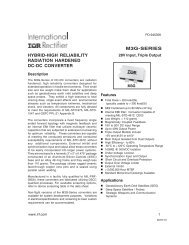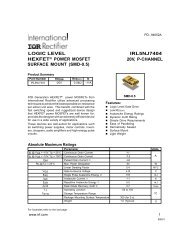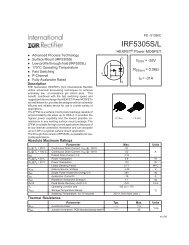Create successful ePaper yourself
Turn your PDF publications into a flip-book with our unique Google optimized e-Paper software.
Sept 7, 2009<strong>IRS2158D</strong>(S)Advanced InformationFeatures• Ballast control and half-bridge driver in one IC• Programmable half-bridge over-currentprotection• Programmable preheat frequency• Programmable preheat time• Programmable ignition ramp• Programmable run frequency• Closed-loop ignition current regulation• Voltage-controlled oscillator (VCO)• Programmable deadtime• End-of-life window comparator pin• Internal 60-event current sense up/down faultcounter• Lamp removal/auto-restart shutdown pin• Brownout protection• Low offset op amp• Internal bootstrap MOSFET• Internal 15.6 V zener clamp diode on Vcc• Micropower startup (250 μA)• Latch immunity and ESD protectionProduct SummaryTopologyHalf-BridgeV OFFSETVio (typical)I o+ & I o- (typical)600 V0V180 mA & 260 mAStart-up current (typical) 250 µAPackage OptionsPDIP16SOICN16Typical Applications• Fluorescent lamp ballast dimming (
<strong>IRS2158D</strong>(S)Table of ContentsDescription..........................................................................................................................................................3Qualification Information.....................................................................................................................................4Absolute Maximum Ratings................................................................................................................................5Recommended Operating Conditions ................................................................................................................6Recommended Component Values ...................................................................................................................6Electrical Characteristics ....................................................................................................................................7Functional Block Diagram.................................................................................................................................10Input/Output Pin Equivalent Circuit Diagrams ..................................................................................................11Lead Definitions ................................................................................................................................................12Lead Assignments ............................................................................................................................................12State Diagram...................................................................................................................................................13Timing Diagram Ballast Section .......................................................................................................................14Application Information and Additional Details .................................................................................................15Parameter Temperature Trends........................................................................ Error! Bookmark not defined.Package Details: PDIP16 and SOIC16N..........................................................................................................27Package Details: SOIC16N, Tape and Reel ....................................................................................................28Part Marking Information ..................................................................................................................................29Ordering information.........................................................................................................................................30www.irf.com2© 2009 <strong>International</strong> <strong>Rectifier</strong>
<strong>IRS2158D</strong>(S)DescriptionThe <strong>IRS2158D</strong> is a fully integrated, fully protected 600V ballast control IC designed to drive all types offluorescent lamps. The <strong>IRS2158D</strong> features include programmable preheat and run frequencies,programmable preheat time, closed-loop half-bridge ignition current regulation, programmable end-of-lifeprotection, brownout protection and low input offset op amp. The op amp can be used for dimming, currentor power control. Comprehensive protection features such as protection from failure of a lamp to strike,filament failures, end-of-life protection, have been included in the design. The <strong>IRS2158D</strong> is available in both16-pin PDIP and 16-pin narrow body SOIC packages.www.irf.com3© 2009 <strong>International</strong> <strong>Rectifier</strong>
<strong>IRS2158D</strong>(S)Qualification Information † Industrial ††Qualification LevelMoisture Sensitivity LevelMachine ModelESDHuman Body ModelIC Latch-Up TestRoHS CompliantComments: This family of ICs has passed JEDEC’sIndustrial qualification. IR’s Consumer qualification level isgranted by extension of the higher Industrial level.MSL2 †† 260°CSOIC16N(per IPC/JEDEC J-STD-020)Not applicablePDIP16(non-surface mount package style)Class B(per JEDEC standard JESD22-A115)Class 3A(per EIA/JEDEC standard EIA/JESD22-A114)Class I, Level A(per JESD78)Yes† Qualification standards can be found at <strong>International</strong> <strong>Rectifier</strong>’s web site http://www.irf.com/†† Higher qualification ratings may be available should the user have such requirements. Please contactyour <strong>International</strong> <strong>Rectifier</strong> sales representative for further information.††† Higher MSL ratings may be available for the specific package types listed here. Please contact your<strong>International</strong> <strong>Rectifier</strong> sales representative for further information.www.irf.com4© 2009 <strong>International</strong> <strong>Rectifier</strong>
<strong>IRS2158D</strong>(S)Absolute Maximum RatingsAbsolute Maximum Ratings indicate sustained limits beyond which damage to the device may occur. Allvoltage parameters are absolute voltages referenced to COM, all currents are defined positive into any lead.The Thermal Resistance and Power Dissipation ratings are measured under board mounted and still airconditions.Symbol Definition Min. Max. UnitsVB VB Pin High-Side Floating Supply Voltage -0.3 625 VVS VS Pin High-Side Floating Supply Offset Voltage VB – 25 VB + 0.3VHO HO Pin High-Side Floating Output Voltage VS - 0.3 VB + 0.3VLO LO Pin Low-Side Output Voltage -0.3 VCC + 0.3IOMAXMaximum allowable output current (HO, LO) due toexternal power transistor miller effect-500 500 mAVCPH CPH Pin Voltage -0.3 VCC + 0.3 VIVCO VCO Pin Current -5 5 mAIFMIN FMIN Pin CurrentVVCO VCO Pin Voltage -0.3 VCC + 0.3 VVNINV NINV pin voltageVINV INV pin voltageVOUT OUT pin voltageVCT CT Pin VoltageICT CT Pin Current -5 5 mAVDC VDC Pin Voltage -0.3 VCC + 0.3 VIDC VDC Pin Current -5 5 mAVSD/EOL SD/EOL Pin Voltage -0.3 VCC + 0.3 VISD/EOL SD/EOL Pin Current -5 5 mAVCS CS Pin Voltage -0.3 VCC + 0.3 VICS CS Pin Current -5 5 mAdV/dt Allowable VS Pin Offset Voltage Slew Rate -50 50 V/nsPD Package Power Dissipation @ TA ≤ +25ºC (16-Pin DIP) --- 1.3 WPD = (TJMAX-TA)/RθJA (16-Pin SOIC) --- 1.4 WRθJA Thermal Resistance, Junction to Ambient (16-Pin DIP) --- 70 ºC/W(16-Pin SOIC) --- 82TJ Junction Temperature -55 150 ºCTS Storage Temperature -55 150TL Lead Temperature (soldering, 10 seconds) --- 300† This IC contains a zener clamp structure between the chip VCC and COM which has a nominalbreakdown voltage of 15.6V. This supply pin should not be driven by a DC, low impedance powersource greater than the VCLAMP specified in the Electrical Characteristics section.www.irf.com5© 2009 <strong>International</strong> <strong>Rectifier</strong>
<strong>IRS2158D</strong>(S)Recommended Operating ConditionsFor proper operation the device should be used within the recommended conditions.Symbol Definition Min. Max. UnitsVB-VS High Side Floating Supply Voltage VBUV+ VCLAMPVS Steady State High-side Floating Supply Offset-1 600 VVCCVSupply l Voltage VCCUV+ VCLAMPICC VCC Supply Current †† 10ISD/EOL SD/EOL Pin CurrentmA-1 1ICS CS Pin CurrentVVCO VCO Pin Voltage 0 5 VRFMIN FMIN Pin Programming Resistor 10 300 kΩTJ Junction Temperature -40 125 ºC†† Enough current should be supplied into the VCC pin to keep the internal 15.6V zener clamp diode onthis pin regulated at its voltage, V CLAMP.Recommended Component ValuesSymbol Component Min. Max. UnitsRFMIN R FMIN Pin Resistor Value 10 --- kΩCT CT Pin Capacitor Value 330 --- pFwww.irf.com6© 2009 <strong>International</strong> <strong>Rectifier</strong>
<strong>IRS2158D</strong>(S)Electrical CharacteristicsVCC = VBS = VBIAS=14V +/- 0.25V, CLO = CHO = 1000pF, CT = 1000pF, RFMIN = 15kΩ,VCPH = VVCO = 0V, VSD/EOL = 0V, VCS = 0V, TA=25 °C unless otherwise specified.Symbol Definition Min Typ Max Units Test ConditionsSupply CharacteristicsVVCC Supply Under-voltage PositiveCCUV+11.5 12.5 13.5 VCC rising from 0VGoing ThresholdVVCC Supply Under-voltage NegativeVCC falling fromCCUV-9.5 10.5 11.5 VGoing Threshold14VVVCC Supply Under-voltage LockoutUVHYS1.0 2.0 3.0HysteresisI QCCUV UVLO Mode VCC Quiescent Current --- 250 500 VCC = 8VµAI QCCFLT FAULT Mode VCC Quiescent Current --- 350 700 MODE=FAULTMODE = RUN,I CC VCC Supply Current --- 3.5 --- mAVVCO = 5VV CLAMP VCC Zener Clamp Voltage 14.6 15.6 16.6 V ICC = 5mAFloating Supply CharacteristicsI BS VBS Supply Current --- 1.0 --- mA MODE = RUNI QBSUV UVLO Mode VBS Quiescent Current --- --- 50 µA VBS = 6VVVBS Supply Under-voltage PositiveBSUV+9.0 10.0 11.0 VBS rising from 0VGoing ThresholdVVVBS Supply Under-voltage NegativeVBS falling fromBSUV-8.0 9.0 10.0Going Threshold14VI LKVS VS Offset Supply Leakage CurrentVB = VS = 650V,--- --- 50 µAVCC = 8VBallast Control Preheat, Ignition and Run Mode CharacteristicsCPH Pin End Of Preheat RisingThreshold Voltage8.8 9.3 9.8V CPHSOI-CPH Pin Start Of Ignition FallingThreshold Voltage4.4 4.7 5.0V VCOPH VCO Pin Preheat Mode Voltage --- 0 ---VMODE = PREHEATV CPHEOP+V VCOIGN VCO Pin Ignition Mode Voltage --- 0.65 ---I VCOIGNVCO Pin Ignition Regulation DischargeCurrent--- 215 --- µAMODE = IGNITION,VCS = 1.5V,RPH = 22.1kΩMODE = IGNITION,VVCO = VVCOIGN,VCS = 1.5VCPH Pin Run Mode Rising ThresholdV CPHRUN+8.8 9.3 9.8 MODE = IGNITIONVoltageVV VCORUN VCO Pin Run Mode Voltage --- OPEN ---MODE = RUNwww.irf.com7© 2009 <strong>International</strong> <strong>Rectifier</strong>
<strong>IRS2158D</strong>(S)Electrical Characteristics (cont’d)VCC = VBS = VBIAS=14V +/- 0.25V, CLO = CHO = 1000pF, CT = 1000pF, RFMIN = 15kΩ,VCPH = VVCO = 0V, VSD/EOL = 0V, VCS = 0V, TA= °C unless otherwise specified.Ballast Control Protection Circuitry CharacteristicsV CSTH+ CS Pin Over-current Sense Threshold 1 1.2 1.4 Vn EVENTSCS and EOL Fault Counter No. ofEvents--- 60 --- EventsV SDTH+SD Pin Rising Non-latched ShutdownThreshold Voltage4.5 5.0 5.5V SDTH-SD Pin Falling Reset ThresholdVoltage2.7 3.0 3.3V EOLBIAS EOL Pin Internal Bias Voltage 1.8 2.0 2.2V EOLTH+V EOLTH-EOL Pin Rising Latched ShutdownThreshold VoltageEOL Pin Falling Latched ShutdownThreshold VoltageV DC+ VDC Pin Enable 4.5 5.0 5.5V DC- VDC Pin Disable 2.7 3.0 3.4I EOLSOURCEEOL Pin OTA Output SourcingCurrentMODE = PREHEATor RUN2.7 3.0 3.3 V MODE = RUN0.9 1.0 1.1 MODE = RUN--- 10 ---I EOLSINK EOL Pin OTA Output Sinking Current --- -10 ---V CPHFLTV VCOFLTV FMINFLTCPH Pin Fault Mode VoltageVCO Pin Fault Mode VoltageFMIN Pin Fault Mode VoltageμAALL MODESMODE = PREHEATVEOL = 1.5VMODE = PREHEATVEOL = 2.5V--- 0 --- V MODE = FAULTBallast Control Oscillator Characteristicsf RUN Half-bridge Oscillator Run Frequency 42.5 45.5 48.5 kHz MODE = RUNf PHHalf-bridge Oscillator PreheatRPH = 22.1kΩ,63 68 73 kHzFrequencyMODE = PREHEATV CT+ Upper CT Ramp Voltage Threshold --- 5.0 ---VMODE = RUNV CT- L CT Ramp Voltage Threshold --- 2.0 ---MODE = RUNd Oscillator duty cycle --- 50 --- %td LO LO Output Deadtime --- 1.5 ---μstd HO HO Output Deadtime --- 1.5 ---MODE = RUN, td LOand td HO removedV FMIN FMIN Pin Voltage 4.6 5.0 5.4 V VCC = 14.0Vwww.irf.com8© 2009 <strong>International</strong> <strong>Rectifier</strong>
<strong>IRS2158D</strong>(S)Electrical Characteristics (cont’d)VCC = VBS = VBIAS=14V +/- 0.25V, CLO = CHO = 1000pF, CT = 1000pF, RFMIN = 15kΩ,VCPH = VVCO = 0V, VSD/EOL = 0V, VCS = 0V, TA=25 °C unless otherwise specified.Gate Driver Output Characteristics (HO, LO)V OL Low-Level Output Voltage --- 0 100 IO = 0mVV OH High-Level Output Voltage --- 0 100VBIAS - VO , IO = 0tr Turn-On Rise Time --- 120 180tf Turn-Off Fall Time --- 50 100I 0+ Source Current --- 180 ---I 0- Sink Current --- 260 ---Bootstrap FET CharacteristicsVB ON VB when the bootstrap FET is on 13.7 14.0 --- VnsmAC HO =C LO = 1nFIB CAP VB source current when FET is on 30 55 --- mA VB = COMIB 10V VB source current when FET is on 8 12 ---VB=10VOp Amp CharacteristicsI ib NINV and INV pin Input bias current --- --- 0.1 µAV io Input Offset Voltage -10 0 10 mVI OUT+ OUT pin Sink Output Current --- 12 --- INV=7V, NINV=0VmAI OUT- OUT pin Source Output Current --- 14 ---INV=7V, NINV=14VVic Common Mode Input Range 0 --- 11.5 VUnity Gain BW Operational Amplifier Band Width --- 2.0 --- MHzG DC DC Open Loop Gain --- 110 --- dBGuaranteed ByDesignwww.irf.com9© 2009 <strong>International</strong> <strong>Rectifier</strong>
<strong>IRS2158D</strong>(S)Functional Block Diagramwww.irf.com10© 2009 <strong>International</strong> <strong>Rectifier</strong>
<strong>IRS2158D</strong>(S)Input/Output Pin Equivalent Circuit DiagramsVBESDDiodeHOVSESDDiode25VVCCESDDiodeVCC600VCTESDDiodeRDTRESDLO,OUTESDDiode25VCOMESDDiodeCOMVCCVCCVDC,NINV,INV,SD/EOL.CSESDDiodeESDDiodeRESDCPHESDDiodeESDDiodeRDTRESDCOMCOMVCCVCCVCOESDDiodeFMINESDDiodeESDDiodeRIGNREGESDDiodeRESDCOMCOMwww.irf.com11© 2009 <strong>International</strong> <strong>Rectifier</strong>
<strong>IRS2158D</strong>(S)Lead DefinitionsPin# Symbol Description1 CPH Preheat Timing Input2 FMIN Oscillator Minimum Frequency Setting3 VCO Voltage Controlled Oscillator / Ignition Ramp Input4 CT Oscillator timing capacitor input5 VDC DC Bus monitoring / Brownout protection6 OUT Dimming OpAmp Output7 NINV Non-inverting pin of Dimming OpAmp8 INV Inverting pin of Dimming OpAmp9 SD/EOL Shut-Down / End of Life Sensing Input10 CS Half-Bridge Current Sensing Input11 LO Low-Side Gate Driver Output12 COM IC Power & Signal Ground13 VCC Logic & Low-Side Gate Driver Supply14 VB High-Side Gate Driver Floating Supply15 VS High Voltage Floating Return16 HO High-Side Gate Driver OutputLead AssignmentsCPH116HOFMIN215VSVCO314VBCT413VCCVDC512COMOUT611LONINV710CSINV89SD/EOLwww.irf.com12© 2009 <strong>International</strong> <strong>Rectifier</strong>
<strong>IRS2158D</strong>(S)State DiagramPower Turned OnSD/EOL > 5.0V (VSDTH+)(Lamp Removal)orVCC < 10.5V (VCCUV-)(Power Turned Off)UVLO Mode1 / 2 -Bridge OffI QCCUV ~250uACPH = 0VVCO = 0V (Oscillator Off)VCC > 12.5V (VCCUV+)andVDC+ > 5.0VandSD/EOL 1.2V for60 eventsPREHEAT Mode1 / 2-Bridge oscillating@ f PHVCO = 0VRPH // RFMINCPH Charging through RCPHCS Fault Counter EnabledCPH dischargedCPH> (2/3)*VCC(End of PREHEAT Mode)SD/EOL>5.0V (VSDTH+)CPH< (1/3)*VCC(Start of IGNITION Mode)CS1.2VIGNITION ModeCPH charging through RCPHVCO charging through RPHCS Shutdown DisabledEOL Shutdown DisabledRegulated ignition frequencyCPH> (1/2)*VCC(End of IGNITION Mode)CS > 1.2V (VCSTH+)PRE-RUN ModeCPH charging through RCPHVCO charging through RPHfrequency ramps to f RUNCS One Fault EnabledEOL Shutdown DisabledCS > 1.2V (VCSTH+) for 60 eventsorSD/EOL < 1.0V (VEOLTH-)For 60 LO CyclesorSD/EOL > 3.0V (VEOLTH+)For 60 LO CyclesCPH> (2/3)*VCC(End of PRE-RUN Mode)RUN ModeVCO = 5V1/2-Bridge Oscillating@f RUNCS Fault Counter EnabledEOL Thresholds EnabledSD/EOL>5.0V (VSDTH+)www.irf.com13© 2009 <strong>International</strong> <strong>Rectifier</strong>
<strong>IRS2158D</strong>(S)Timing Diagram Ballast SectionVCC15.6VUVLO+UVLO-CPH(2/3)*VCC(1/2)*VCC(1/3)*VCC5VVCOtRAMP=RPH*CVCOf run(RFMIN)FREQf ph(RFMIN//RPH)SDHO, LOCS1.2VUVLOSD > 5VPH FAULTPHPRE RUN UVLOIGNIGN RUNHOHOHODTLOLO1.2VLOCSCSCS5VCT2V5VCT2V5VCT2Vwww.irf.com14© 2009 <strong>International</strong> <strong>Rectifier</strong>
<strong>IRS2158D</strong>(S)3006FREQ(kHz250200150100330pF680pF1nF1.5nFVCT+,-(V)5432VCT+501VCT-00 20 40 60 80 100RFMIN(KΩ)FREQ vs RFMIN vs CT(<strong>IRS2158D</strong>)011 12 13 14 15VCC(V)VCT+,- vs VCC (<strong>IRS2158D</strong>)RFMIN=15KΩ, CT=1nFGraph 1. Run Frequency vs RFMIN and CTGraph 2. CT voltage thresholds vs VCC14016FREQ(kHz)120100806040330pF680pF1nF1.5nFICC(mA)141210864202011 12 13 14 15VCC(V)FREQ vs VCC vs CTRFMIN=15KΩ(<strong>IRS2158D</strong>)00 50 100 150 200 250 300FREQ(kHz)ICC vs FREQ (<strong>IRS2158D</strong>)RFMIN=15KΩ, CT=330pFGraph 3. Run Frequency vs VCC and CTGraph 4. ICC vs Frequencywww.irf.com15© 2009 <strong>International</strong> <strong>Rectifier</strong>
<strong>IRS2158D</strong>(S)2.52.522TDHO(uS)1.51TDLO(uS)1.510.50.500.300 0.600 0.900 1.200 1.500CT(nF)00.300 0.600 0.900 1.200 1.500CT(nF)TDHO vs CT(<strong>IRS2158D</strong>)VCC=14V, RFMIN=15KΩTDLO vs CT(<strong>IRS2158D</strong>)VCC=14V, RFMIN=15KΩGraph 5. Dead Time TDHO vs CTGraph 6. Dead Time TDLO vs CT2.52.02.52TDHO(uS)1.51.0TDLO(uS)1.510.50.0330pF1nF680pF1.5nF11 12 13 14 15VCC(V)0.50330pF1nF680pF1.5nF11 12 13 14 15VCC(V)TDHO vs VCC vs CT(<strong>IRS2158D</strong>)RFMIN=15KΩTDLO vs VCC vs CT(<strong>IRS2158D</strong>)RFMIN=15KΩGraph 7. Dead Time TDHO vs VCCGraph 8. Dead Time TDLO vs VCCwww.irf.com16© 2009 <strong>International</strong> <strong>Rectifier</strong>
<strong>IRS2158D</strong>(S)VFMIN(V)5.1005.0755.0505.0255.0004.9754.9504.9254.90011 12 13 14 15VCC(V)VFMIN vs VCC(<strong>IRS2158D</strong>)VCC=14V, RFMIN=15KΩIQCC(mA)201816141210864200 5 10 15 20VCC(V)IQCC vs VCC (<strong>IRS2158D</strong>)Graph 9. VFMIN vs VCCGraph 10. IQCC vs VCC5.0004.000Vio(mV)3.0002.0001.0000.00011 12 13 14 15VCC(V)Vio vs VCC(<strong>IRS2158D</strong>)Graph 11. Vio vs VCCwww.irf.com17© 2009 <strong>International</strong> <strong>Rectifier</strong>
<strong>IRS2158D</strong>(S)Application Information and Additional DetailsInformation regarding the following topics is included as subsections within this section of the datasheet:• Under-Voltage Lock-Out (UVLO) Mode and IC Supply Circuitry• Preheat Mode (PH)• Ignition Mode (IGN)• Pre-Run Mode• Run Mode (RUN)• Dimming• SD/EOL and CS Fault Mode• Brown-out protection• Component Selection• Vcc double filter• PCB Layout GuidelinesUnder-voltage Lock-Out Mode (UVLO) Mode and IC Supply CircuitryThe under-voltage lock-out mode (UVLO) is defined as the state the IC is in when VCC is below the turn-onthreshold of the IC. To identify the different modes of the IC, refer to the State Diagram shown on page 14 ofthis document. The <strong>IRS2158D</strong> undervoltage lock-out is designed to maintain an ultra low supply current ofless than 500 μA, and to guarantee the IC is fully functional before the high- and low-side output drivers areactivated. Figure 1 shows an efficient supply voltage using the micro-power start-up current of the<strong>IRS2158D</strong> together with a snubber charge pump from the half-bridge output (R VCC , C VCC1 , C VCC2 , C SNUB , D CP1and D CP2 ).V RECT (+)V BUS (+)R VCCHO R HO16 MHSVS15To LoadBSFET VB14BSFETCONTROLVCC13C BSR 2C VCC2R 1D CP2C SNUBCOM12C VCC1LO11R LOMLSD CP1CS10R 3<strong>IRS2158D</strong>C CSR CSV BUS (-)IC COMLoadReturnFigure 1: Start-up and supply circuitry.The VCC capacitors (C VCC1 and C VCC2 ) are charged by the current through supply resistor (R VCC ) minus thestart-up current drawn by the IC. This resistor is chosen to set the desired AC line input voltage turn-onthreshold for the ballast. When the voltage at VCC exceeds the IC start-up threshold (VCCUV+) and theVDC pin is above 5 V and the SD pin is below 3 V, the IC turns on and LO begins to oscillate. Thecapacitors at VCC begin to discharge due to the increase in IC operating current (Figure 2). The high-sidesupply voltage, VB-VS, begins to increase as capacitor C BS is charged through the internal bootstrapMOSFET during the LO on-time of each LO switching cycle. When the VB-VS voltage exceeds the high-sidestart-up threshold (VBSUV+), HO then begins to oscillate. This may take several cycles of LO to charge VB-VS above VBSUV+ due to RDSon of the internal bootstrap MOSFET.www.irf.com18© 2009 <strong>International</strong> <strong>Rectifier</strong>
<strong>IRS2158D</strong>(S)V C1C VCCDISCHARGEINTERNAL VCCZENER CLAMP VOLTAGEV UVLO+VHYSTV UVLO-DISCHARGETIMECHARGE PUMPOUTPUTR VCC & C VCC1,2TIMECONSTANTtFigure 2: VCC supply voltage.When LO and HO are both oscillating, the external MOSFETs (MHS and MLS) are turned on and off with a50% duty cycle and a non-overlapping deadtime of 1.5 μs. The half-bridge output (pin VS) begins to switchbetween the DC bus voltage and COM. During the deadtime between the turn-off of LO and the turn-on ofHO, the half-bridge output voltage transitions from COM to the DC bus voltage at a dv/dt rate determined bythe snubber capacitor (C SNUB ). As the snubber capacitor charges, current will flow through the charge pumpdiode (D CP2 ) to VCC. After several switching cycles of the half-bridge output, the charge pump and theinternal 15.6 V zener clamp of the IC take over as the supply voltage. Capacitor C VCC2 supplies the ICcurrent during the VCC discharge time and should be large enough such that VCC does not decrease belowVCCUV- before the charge pump takes over. Capacitor C VCC1 is required for noise filtering and must beplaced as close as possible and directly between VCC and COM, and should not be lower than 0.1uF.Additional resistors are recommended for limiting high currents that can flow to VCC from the charge pumpduring hard-switching of the half-bridge or during lamp ignition. In the application circuit shown above, DCP2is a 17 V zener diode, which serves to limit the voltage transients that are supplied to VCC through thecharge pump, under these conditions. The IC may not operate correctly if steps are not taken to preventoverdriving VCC through the charge pump.The internal bootstrap MOSFET and supply capacitor (C BS ) comprise the supply voltage for the high sidedriver circuitry. During UVLO mode, the high- and low-side driver outputs HO and LO are both low, theinternal oscillator is disabled, and pin CPH is connected internally to COM for resetting the preheat time.Preheat Mode (PH)The <strong>IRS2158D</strong> enters preheat mode when VCC exceeds the UVLO positive-going threshold (VCCUV+) andthe VDC pin voltage is above the 5 V threshold. The internal MOSFET that connects pin CPH to COM isturned off and an external resistor (Figure 3) begins to charge the external preheat timing capacitor (CPH).LO and HO begin to oscillate at a higher soft-start frequency and ramp down quickly to the preheatfrequency. The VCO pin is connected to COM through an internalwww.irf.com19© 2009 <strong>International</strong> <strong>Rectifier</strong>
<strong>IRS2158D</strong>(S)V BUS (+)R CPH4VCCC PH CPH3HOMODE 16MHSC VCOVCOM1Half-BridgeOutputHalf-BridgeDriverVS15R PHI LOADFMIN5R FMINOSC.11LOMLS10CSR 3<strong>IRS2158D</strong>C CS12 R CSCOMLoadReturnV BUS (-)Figure 3: Preheat circuitry.MOSFET so the preheat frequency is determined by the equivalent resistance at the FMIN pin formed by theparallel combination of resistors RMIN and RPH. The frequency remains at the preheat frequency until thevoltage on pin CPH exceeds 2/3*VCC (VCPHEOP) and the IC enters Ignition Mode. During preheat mode,the over-current protection on pin CS (VCSTH+) and the 60-cycle consecutive over-current fault counter(nEVENTS) are both enabled.Ignition Mode (IGN)The <strong>IRS2158D</strong> ignition mode is defined by the second time CPH charges from 1/3*VCC (VCPHSOI-) to1/2*VCC (VCHPRUN). When the voltage on pin CPH exceeds 2/3*VCC (VCPHEOP) for the first time, pinCPH is discharged quickly through an internal MOSFET down to 1/3*VCC (VCPHSOI-) (see Figures 4 and 5).The internal MOSFET turns off and the voltage on pin CPH begins to increase again. The internal MOSFETat pin VCO turns off and resistor RPH is disconnected from COM. The equivalent resistance at the FMIN pinincreases from the parallel combination (RPH//RMIN) to RMIN at a rate programmed by the externalcapacitor at pin VCO (CVCO) and resistor RPH. This causes the operating frequency to ramp downsmoothly from the preheat frequency through the ignition frequency to the final run frequency. During thisignition ramp, the frequency sweeps towards the resonance frequency of the lamp output stage to ignite thelamp.VCPH2/3*VCC1/2*VCC1/3*VCCVVCOtPH = RCPH * CPHt5VtRAMP = RPH * CVCOPREHEATIGNPRERUNRUNtFigure 4: CPH and VCO timing diagram.www.irf.com20© 2009 <strong>International</strong> <strong>Rectifier</strong>
<strong>IRS2158D</strong>(S)V BUS (+)VCCR CPHC PH CPH3C VCO VCO4HOMODE 16M1Half-BridgeDriverVS15MHSHalf-BridgeOutputR PHFMIN5R FMIN1.2KOSC.LO11MLSI LOADM2+- 1.2VCS10R 3<strong>IRS2158D</strong>C CS12 COR CSMLoadReturnV BUS (-)Figure 5: Ignition circuitry.The over-current threshold on pin CS (VCSTH+) will protect the ballast against a non-strike or open-filamentlamp fault condition. The voltage on pin CS is defined by the lower half-bridge MOSFET current flowingthrough the external current sensing resistor RCS. This resistor programs the maximum peak ignition current(and therefore peak ignition voltage) of the ballast output stage. Should this voltage exceed the internalVCSTH+ threshold of 1.2 V, the ignition regulation circuit discharges the VCO voltage slightly to increase thefrequency slightly (see Figure 6). This cycle-by-cycle feedback from the CS pin to the VCO pin will adjustthe frequency each cycle to limit the amplitude of the current for the entire duration of ignition mode.HOLOVSVCSt1.2VtVVCO5VtFigure 6: Ignition regulation timing diagram.The <strong>IRS2158D</strong> remains in IGNITION mode until the voltage at CPH reaches 1/2*VCC at which point it willswitch into PRE-RUN mode.Pre-Run ModeIn PRE-RUN mode the fault counter is disables so that the <strong>IRS2158D</strong> will enter FAULT mode if a singleevent occurs where VCS>1.2 V (VCSTH+). This allows the ballast to shut down if the resonant inductorsaturates during ignition.www.irf.com21© 2009 <strong>International</strong> <strong>Rectifier</strong>
<strong>IRS2158D</strong>(S)When CPH exceeds 2/3*VCC (VCPHRUN+) for the second time, the IC enters run mode and the faultcounter becomes enabled. The ignition regulation is not active in run mode but the IC will enter fault modeafter 60 consecutive over-current faults and gate driver outputs HO and LO will be latched low.Run Mode (RUN)Once VCPH has exceeded 2/3*VCC for the second time (VCPHRUN), the IC enters run mode. CPHcontinues to charge up to VCC. The operating frequency is at the minimum frequency (after the ignitionramp) and is programmed by the external resistor (RMIN) at the FMIN pin. Should hard-switching occur atthe half-bridge at any time (open-filament, lamp removal, etc.), the voltage across the current sensingresistor (RCS) will exceed the internal VCSTH+ threshold of 1.2 V and the fault counter will begin counting(see Figure 5). Should the number of consecutive over-current faults exceed 60 (nEVENTS), the IC willenter fault mode and the HO and LO gate driver outputs will be latched low. During run mode, the end-of-life(EOL) window comparator and the DC bus under-voltage reset are both enabled.DimmingThe application diagram shows how the operational amplifier can be configured with the ballast control pinsof the IRS2158 to realize a dimming ballast system, which regulates the lamp arc current. The opamp in thisIC is left uncommitted, so that the designer can utilize it in whatever way they require for the particularapplication, for example it could be used to create a non-dimming ballast with regulated lamp power or amore sophisticated end of lamp life detection circuit.In this example the lamp arc current is compared with a DC control voltage to produce an error voltage thatsteers the frequency by sinking current from the FMIN pin.SD/EOL and CS Fault ModeShould the voltage at the SD/EOL pin exceed 3 V or decrease below 1V (VEOLTH-) during run mode, anend-of-life (EOL) fault condition has occurred. The end of life fault must remain for approximately 60 cyclesof LO before the IC enters fault mode. This is to prevent possible false tripping of the end of life shutdowncircuit caused by surges or transients at the AC line input. LO and HO gate driver outputs are all latched offin the ‘low’ state. CPH is discharged to COM for resetting the preheat time and VCO is discharged to COMfor resetting the frequency. To exit fault mode, VCC can be decreased below VCCUV- (ballast power off) orthe SD pin can be increased above 5 V (VSDTH+) (lamp removal). Either of these will force the IC to enterUVLO mode (see State Diagram, page 13). Once VCC is above VCCUV+ (ballast power on) and SD ispulled above 5 V (VSDTH+) and back below 3 V (VSDTH-) (lamp re-insertion), the IC will enter preheatmode and begin oscillating again.The current sense function will force the IC to enter fault mode only after the voltage at the CS pin hasbeen greater than 1.2 V (VCSTH+) for 60 (nEVENTS) consecutive cycles of LO. The voltage at the CS pinis AND-ed with LO (see Figure 7) so it will work with pulses that occur during the LO on-time or DC. If theover-current faults are not consecutive, then the internal fault counter will count down each cycle when thereis no fault. Should an over-current fault occur only for a few cycles and then not occur again, the counter willeventually reset to zero. The over-current fault counter is enabled during preheat and run modes anddisabled during ignition mode.www.irf.com22© 2009 <strong>International</strong> <strong>Rectifier</strong>
<strong>IRS2158D</strong>(S)60 CyclesLOCS1.2VRun or Preheat ModeFault ModeFigure 7: Fault counter timing diagram.Brown-out protectionThe DC pin senses the voltage on the DC bus by means of an external resistor divider and an internalcomparator with hysterisis. When power is first supplied to the IC at system startup, 3 conditions are requiredbefore oscillation is initiated: 1.) the voltage on the VCC pin must exceed the rising undervoltage lockoutthreshold (VCCUV+), 2.) the voltage at the VDC pin must exceed VDC+, 3.) the voltage at the SD/EOL pinmust be below 3 V. If a low DC bus condition occurs during normal operation, or if power to the ballast isshut off, the DC bus will collapse prior to the VCC of the chip (assuming the VCC is derived from a chargepump off of the output of the half-bridge). In this case, the voltage on the VDC pin will drop below the VDCthresholdand shut the oscillator off, thereby protecting the power transistors from potentially hazardous hardswitching. Approximately 2 V of hysterisis has been designed into the internal comparator sensing the VDCpin, in order to account for variations in the DC bus voltage under varying load conditions. When the DC busrecovers, the chip restarts from the beginning of the control sequence, as shown in timing diagram Figure 8below.VDC53CT5CPH15LO1515HO-VSRUN modeLow VDCRestartFigure 8: VDC pin fault and auto restartwww.irf.com23© 2009 <strong>International</strong> <strong>Rectifier</strong>
<strong>IRS2158D</strong>(S)Ballast Design EquationsNote: The results from the following design equations can differ slightly from actual measurements due to ICtolerances, component tolerances, and oscillator over- and under-shoot due to internal comparator responsetime.Step 1: Program DeadtimeThe deadtime is programmed with the timing resistor RDT at the DT pin. The deadtime is given by:tDT=1500 ⋅C T[Seconds] (1)tDTCT= [Farads] (2)1500Step 2: Program Run FrequencyThe run frequency is programmed with the timing resistor RMIN at the FMIN pin. The run frequency isgiven as:[Hz] (3)fOSCRUNRMIN=2.15⋅CT1⎛ 3⋅⎜⋅ R⎝ 5MIN⎞+ 1500⎟⎠5 ⎛ 1( ) ⎟ ⎞= ⋅⎜−15003 ⎝ 2.15⋅fOSCRUN⋅CT⎠[Ohms] (4)Step 3: Program Preheat FrequencyThe preheat frequency is programmed with timing resistors RMIN and RPH. The timing resistors areconnected in parallel for the duration of the preheat time. The preheat frequency is therefore given as:[Hertz] (5)fOSCPH=2.15⋅CT1⎛ 3 ( R⋅⎜ ⋅⎝ 5MIN⋅ RPH) ⎞+ 1500( R + ) ⎟ MINRPH⎠Step 4: Program Preheat TimeThe preheat time is defined by the time it takes for the external capacitor on pin CPH to charge up to2/3*VCC. An external resistor (RCPH) connected to VCC charges capacitor CPH. The preheat time istherefore given as:tPH= R ⋅ C[Seconds] (6)CPHPHwww.irf.comor24© 2009 <strong>International</strong> <strong>Rectifier</strong>
<strong>IRS2158D</strong>(S)Step 5: Program Ignition Ramp TimetPHCPH= [Farads] (7)RCPHThe preheat time is defined by the time it takes for the external capacitor on pin VCO to charge up to 5V.The external timing resistor (RPH) connected to FMIN charges capacitor CVCO. The ignition ramp time istherefore given as:tRAMP= R ⋅C[Seconds] (8)PHVCOStep 6: Program Maximum Ignition CurrenttorRAMPCVCO= [Farads] (9)RPHThe maximum ignition current is programmed with the external resistor RCS and an internal threshold of1.2V. This threshold determines the over-current limit of the ballast, which will be reached when thefrequency ramps down towards resonance during ignition and the lamp does not ignite. The maximumignition current is given as:orIIGNRCS1.2= [Amps Peak] (10)RCS1.2= [Ohms] (11)IIGNVCC Double FilterIt is recommended to utilize a double filter arrangement from the charge pump (CSNUB, DCP1 and DCP2)to VCC as shown in the schematic of Figure 9. This circuit is designed to protect the VCC supply pin of the<strong>IRS2158D</strong> from high peak currents that occur when the MOSFET MHS switches VS from COM to VBUS.DCP2 should be an 18 V rated zener diode and RSUPPLY should connect to the cathode of DCP2. This isto protect the VCC input of the <strong>IRS2158D</strong> from possible surges and transient voltages.Figure 9: VCC Double Filter Arrangementwww.irf.com25© 2009 <strong>International</strong> <strong>Rectifier</strong>
<strong>IRS2158D</strong>(S)PCB Layout ConsiderationsIn order to successfully utilize the <strong>IRS2158D</strong> in a ballast design, it is necessary to follow the following PCBlayout guidelines. This can avoid possible interference and ground loop issues that can occur in the ballastcircuit. These connection techniques also prevent high current ground loops from interfering with sensitivetiming component operation and allow the entire control circuit to reject common-mode noise due to outputswitching.Figure 10 and Figure 11 show the control section of typical ballast designed around the <strong>IRS2158D</strong>, wherethe IC is located in the center. In this design all SMD devices are mounted under the PCB with discretedevices on top.CHARGE PUMPWITH FIRST FILTERRESISTORSENSITIVE TIMINGCOMPONENTS<strong>IRS2158D</strong>VCC DECOUPLINGCAPACITORSIGNAL GROUNDSTAR POINT AT IC COMHALF BRIDGECURRENT SENSERESISTORLAMP CURRENTSENSE RESISTORSIGNAL AND POWERGROUNDS JOIN HERESECOND FILTER RESISTORAND CVCCFigure 10: Critical traces on the bottom side of the PCBFigure 11: Critical traces on the top side of the PCB1) The signal ground (pin 12) should only be connected to the power ground at one single point to preventground loops from forming.2) The point described in (1) should be where the grounds of the current sense resistors for both the halfbridge MOSFETs and the lamp current feedback both meet.3) The VCC decoupling capacitor should be placed as close to the <strong>IRS2158D</strong> VCC (pin 13) and COM (pin12) as possible with the shortest possible traces.4) The devices; CPH, RMIN, CVCO, CT and CCS should all be located as close to the <strong>IRS2158D</strong> aspossible with traces to the relevant pins being as short as possible.5) The ground connections from the devices listed in (4) should be connected back to the COM pin of the<strong>IRS2158D</strong> through the shortest possible traces. These should be connected back to the COM pin of theIC without joining the power ground trace at any point. In the example shown above the power groundtrace runs along the lower side of the board on the bottom Copper layer6) The charge pump diode connection to ground should be made to the power ground not the signal ground.7) The power factor correction section (if used) should be kept apart from the ballast control as shown in theexample above. the power factor correction section is at the left side of the PCB.www.irf.com26© 2009 <strong>International</strong> <strong>Rectifier</strong>
<strong>IRS2158D</strong>(S)Package Details: PDIP16 and SOIC16Nwww.irf.com27© 2009 <strong>International</strong> <strong>Rectifier</strong>
<strong>IRS2158D</strong>(S)Package Details: SOIC16N, Tape and ReelLOADED TAPE FEED DIRECTIONBAHDFCNOTE : CONTROLLINGDIMENSION IN MMEGCARRIER TAPE DIMENSION FOR 16SOICNMetricImperialCode Min Max Min MaxA 7.90 8.10 0.311 0.318B 3.90 4.10 0.153 0.161C 15.70 16.30 0.618 0.641D 7.40 7.60 0.291 0.299E 6.40 6.60 0.252 0.260F 10.20 10.40 0.402 0.409G 1.50 n/a 0.059 n/aH 1.50 1.60 0.059 0.062FDECBAGHREEL DIMENSIONS FOR 16SOICNMetricImperialCode Min Max Min MaxA 329.60 330.25 12.976 13.001B 20.95 21.45 0.824 0.844C 12.80 13.20 0.503 0.519D 1.95 2.45 0.767 0.096E 98.00 102.00 3.858 4.015F n/a 22.40 n/a 0.881G 18.50 21.10 0.728 0.830H 16.40 18.40 0.645 0.724www.irf.com28© 2009 <strong>International</strong> <strong>Rectifier</strong>
<strong>IRS2158D</strong>(S)Part Marking Informationwww.irf.com29© 2009 <strong>International</strong> <strong>Rectifier</strong>
<strong>IRS2158D</strong>(S)Ordering informationBase Part NumberPackage TypeStandard PackFormQuantityComplete Part NumberPDIP16 Tube/Bulk 25 <strong>IRS2158D</strong>PBF<strong>IRS2158D</strong>SOIC16NTube/Bulk 45 <strong>IRS2158D</strong>SPBFTape and Reel 2500 <strong>IRS2158D</strong>STRPBFThe information provided in this document is believed to be accurate and reliable. However, <strong>International</strong> <strong>Rectifier</strong> assumes noresponsibility for the consequences of the use of this information. <strong>International</strong> <strong>Rectifier</strong> assumes no responsibility for anyinfringement of patents or of other rights of third parties which may result from the use of this information. No license is granted byimplication or otherwise under any patent or patent rights of <strong>International</strong> <strong>Rectifier</strong>. The specifications mentioned in this documentare subject to change without notice. This document supersedes and replaces all information previously supplied.For technical support, please contact IR’s Technical Assistance Centerhttp://www.irf.com/technical-info/WORLD HEADQUARTERS:233 Kansas St., El Segundo, California 90245Tel: (310) 252-7105www.irf.com30© 2009 <strong>International</strong> <strong>Rectifier</strong>



